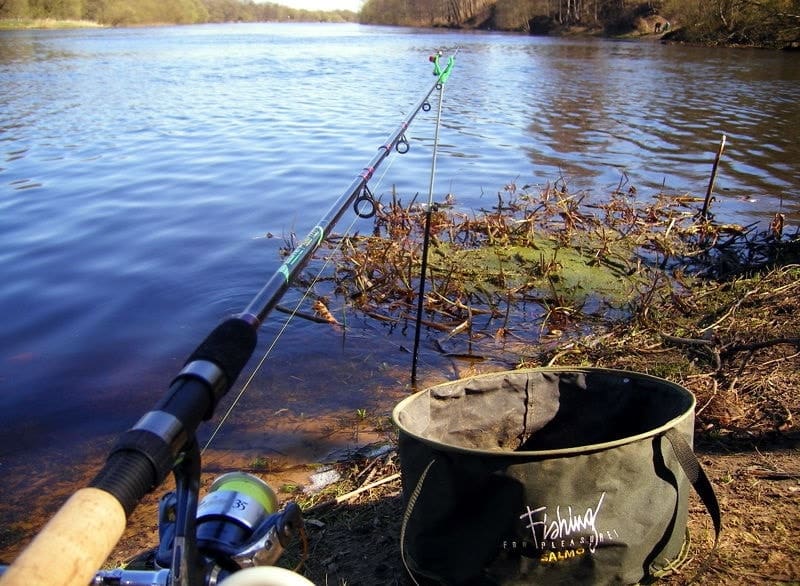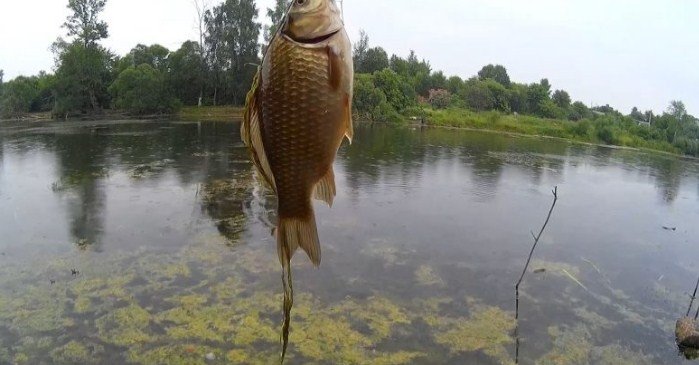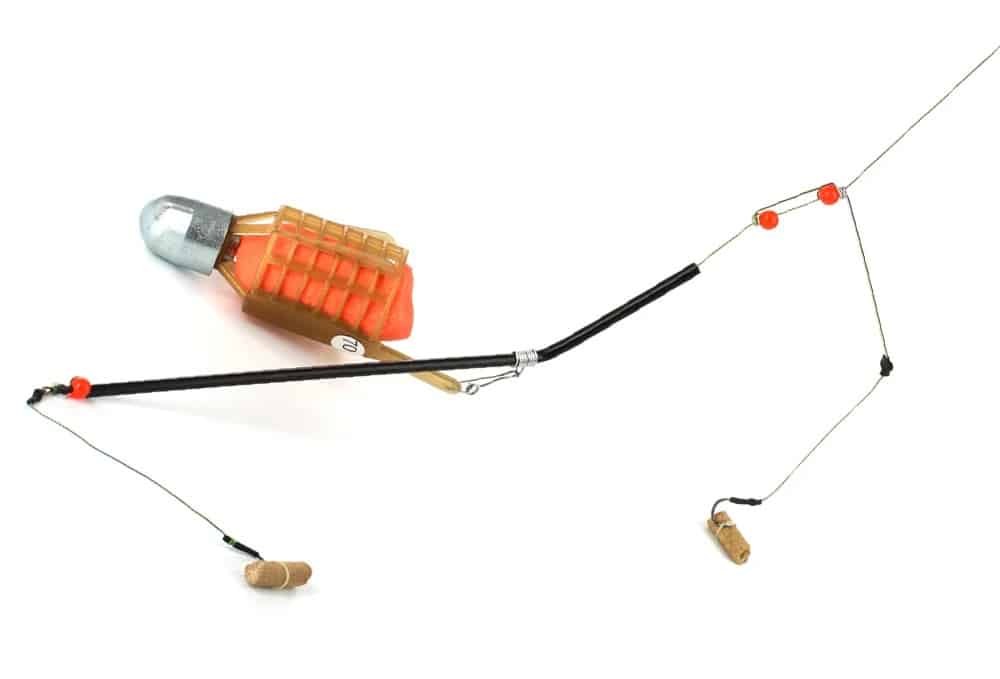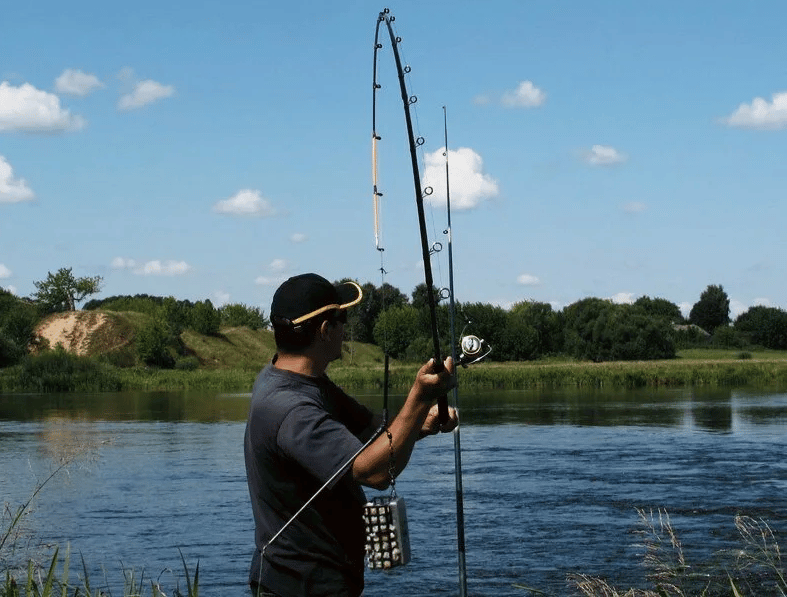The feeder is a popular tackle that is actively used for catching freshwater fish. In order for a fishing trip to bring the desired result, it is important to correctly assemble the feeder tackle and select the most suitable equipment for the specific fishing conditions. Below you can find information regarding the selection process of feeder elements and the secrets of avid anglers.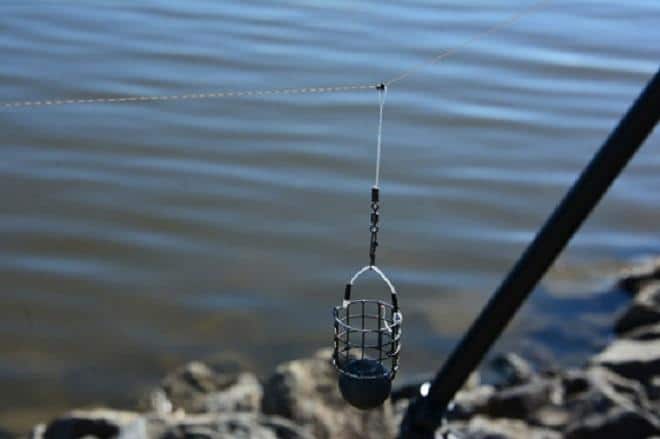
- Feeder tackle: what it is, where and when it is applied
- How to assemble a feeder tackle – accessories and installation
- Rod
- Feeder tackle reel
- Leash mounting
- What feeder to equip the feeder
- Hooks
- Choosing a method of mounting feeder equipment
- How to knit a feeder helicopter
- Paternoster
- Asymmetric hinge
- Features of fishing with a feeder in running water
- How to assemble a feeder for catching carp, crucian carp, roach and bream
- Feeder tackle for bream fishing
- How to equip a feeder rod for carp
- Feeder equipment for catching crucian carp
- How to assemble a roach feeder
- Secrets and Tips
- Поделиться ссылкой:
Feeder tackle: what it is, where and when it is applied
Feeder is called an English bottom tackle with a feeder, which is used for feeding and fishing a certain area of the reservoir. A weight, often combined with a feeder, as well as a hook are the main components of the rig. A nozzle / bait is baited onto the hook and thrown into a pre-fed place of the river. Using a feeder, you can catch a large number of bottom fish, however, in order for the fishing trip to be effective, it is important to adhere to the rules of
feeder fishing . Feeder tackle is actively used for fishing:
- carp ;
- carp ;
- crucian carp ;
- roach;
- bream ;
- gusters.
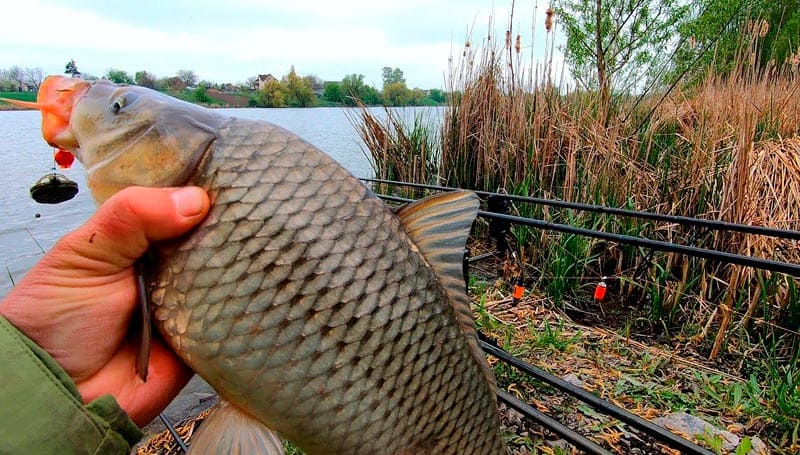
How to assemble a feeder tackle – accessories and installation
Below you can get acquainted with the various types of equipment and the process of selecting the elements of the feeder
Rod
For fishing with a feeder from the coastline, you should use rods, the length of which is 3 – 4.5 meters. If you plan to fish from a boat, you should buy a shorter rod (up to 3-3.5 meters). The tackle should be characterized by increased strength and flexibility.
Note! Modern feeder models are equipped with a set of interchangeable quivertips.
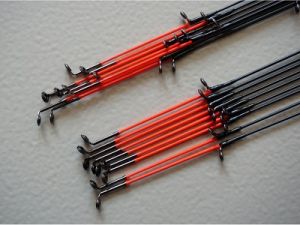
Feeder tackle reel
Heavy
feeder reels are able to withstand significant resistance when playing fish while fishing on the river in the current. The spool must be able to hold more than 150 meters of cord. For fishing on a feeder, a design with a rear or front clutch is suitable. The standard size of the reels for the feeder is 2500-4500 according to Shimano’s classification.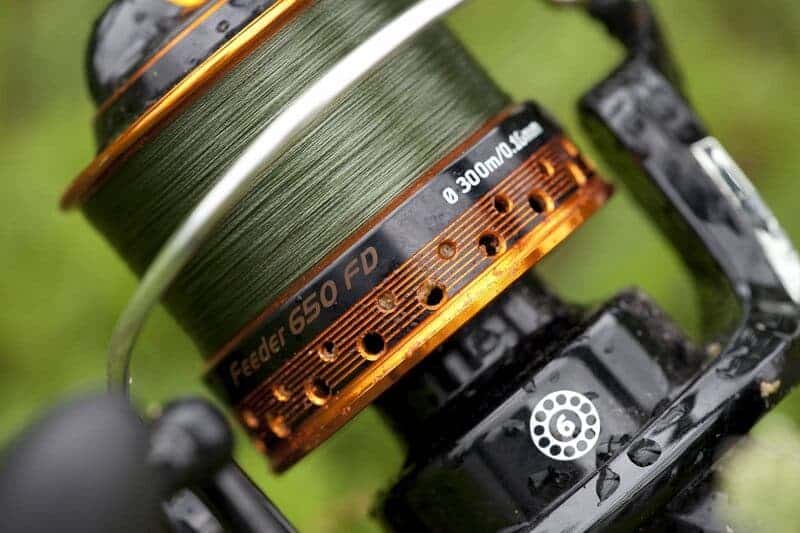
Leash mounting
When fishing in areas of a reservoir with a strong current, it is worth using a monofil or fluorocarbon. Depending on the dimensional characteristics of the prospective production, the diameter and breaking load of the leash depend. Most often, fishermen use leashes with a diameter of 0.2-0.3 mm. Often, for fishing with a feeder on a current, a braid is used
, which is characterized by increased strength with a small diameter. The use of a line makes it easy to cast over long distances. https://tytkleva.net/lovlya-mirnoj-ryby/lovlya-na-fider/kakuyu-pletenku-vybrat.htm
Interesting to know! The braid is highly sensitive and hardly stretches.
What feeder to equip the feeder
In rivers with strong currents, it is advisable to use triangular structures, such are distinguished by good adhesion to the bottom surface. In a moderate current, feeders with square outlines, the mass of which reaches 100 grams, will work perfectly
. To prevent the bait from being washed out quickly, you should use closed-type feeders. https://tytkleva.net/lovlya-mirnoj-ryby/lovlya-na-fider/rybolovnye-kormushki.htm
Hooks
Fishing hooks must be sharp. In the case of active biting, hooks with a long forend and a straight sting should be used. If the fish is cautious, it is better to give preference to short hooks with a sting, which are slightly bent inward. Vegetable attachments are suitable for a short hook, and worms for a long forearm
.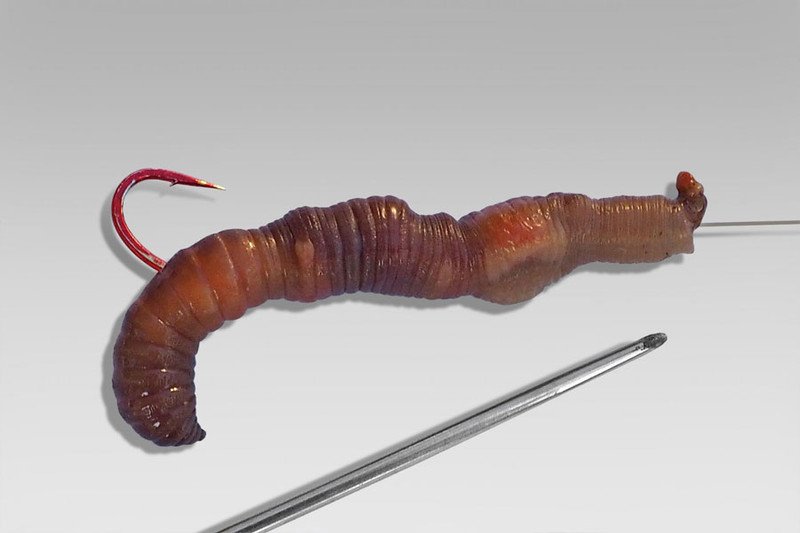
Choosing a method of mounting feeder equipment
Feeder rigs differ in sensitivity. The most sensitive installation methods include an
asymmetric and symmetrical loop. The helicopter is a less sensitive type of installation, however, it is used most often on rivers with strong currents.
How to knit a feeder helicopter
The hook-and-loop leash moves around the base, attracting the attention of the underwater inhabitants. This is the main advantage of the helicopter rig, which is actively used when fishing in areas of water bodies with strong currents. Step-by-step knitting process:
- The fluorocarbon, which is 120 cm long, is folded in half. The diameter of the line should be up to 0.35 mm.
- After stepping back 15 cm, you should make an eight knot and put on a swivel.
- Having retreated another 1 cm, it is necessary to tie the second knot and fix the swivel to the loop with the presence of a fastener for the feeder.
- A hook leash is tied to a swivel, which is located between the knots.
The rig can be used. The bait will be tempting to play on the jets and will help fish self-targeting.
Paternoster
Paternoster is a versatile and effective rig with fairly good sensitivity. The moment of the bite is transmitted to the rod tip. How to attach a feeder to a feeder using a paternoster:
- On a fishing line, the length of which is 50 cm, they make an indent from the edge of about 14-16 cm.
- After that, they knit a loop (15 cm) and fix a swivel on it with a fastener for the feeder.
- At the other end of the line, knit a loop and fix the leash using the loop-to-loop method.
Paternoster is perfect for catching active fish.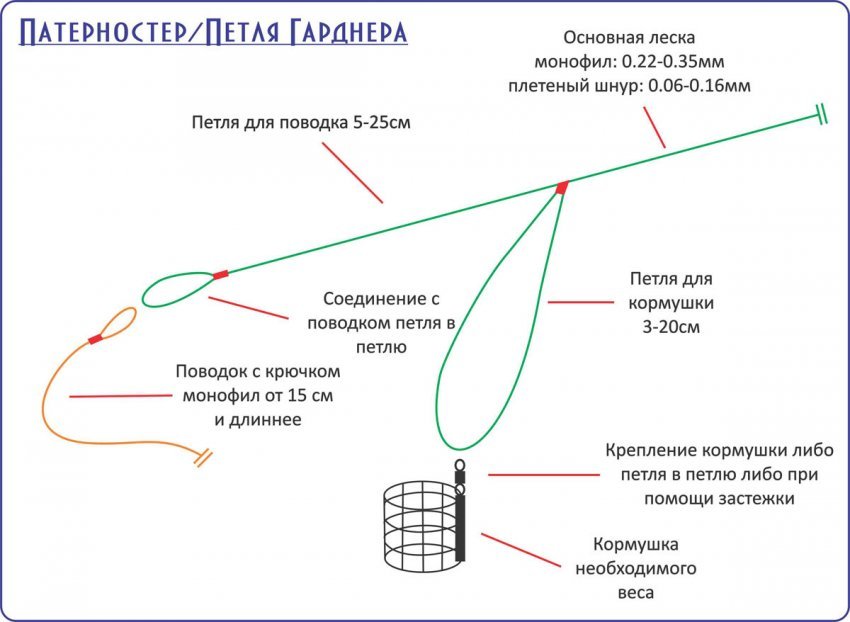
Asymmetric hinge
The asymmetric hinge often gets tangled, making it difficult for novice anglers to handle. However, the asymmetrical loop is one of the most sensitive rigs. Step-by-step process to tie a non-symmetrical loop:
- The fishing line, the length of which reaches 100 cm, is folded in half and an eight-knot is knitted at the tip. It is on it that the leash with a hook will be fixed.
- Behind the knot, twist is performed (10 cm) and fixed with an eight knot.
- On the second tip, you should put on a swivel with a clasp.
- Having retreated 20 cm from the twist, it is worth tying a stopper knot. The length of the tip with the swivel should be a couple of cm longer. Thus, it is possible to obtain an asymmetric shoulder.
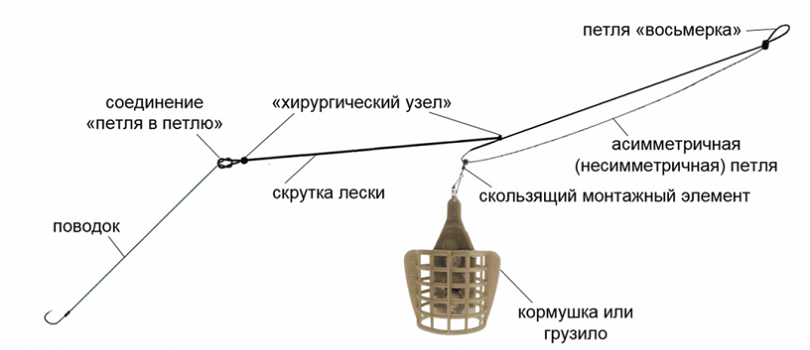
Features of fishing with a feeder in running water
When fishing in areas of a reservoir with a strong current, it is worth using a powerful and flexible enough feeder. It is important to perform the most accurate casts and correctly determine the type of equipment, taking into account the strength of the current. On bodies of water with strong currents, it is worth using feeders with a large weight and streamlined outlines. On such rivers, it is advisable to choose a strong line of small diameter.
Note! Experienced anglers recommend using a helicopter feeder rig when fishing rivers with particularly strong currents.
How to assemble a feeder for catching carp, crucian carp, roach and bream
Depending on how correctly the fisherman has chosen the feeder equipment, the catchability of the feeder will depend. Below you can find information on how to properly assemble your fishing tackle.
Feeder tackle for bream fishing
Before going to the pond, you should assemble the feeder. If the
fishing of bream will be carried out on the river, it is worth using feeders, the mass of which reaches 100 grams. If a pond with stagnant water is fished, a feeder with a small weight of up to 20-40 grams, sufficient to throw the rig to the required distance, will be enough. The recommended rod length is 3-4 meters. In this case, the tackle test can be equal to 120 grams, and the diameter of the leashes should not exceed 0.18-0.22 mm. When choosing hooks, it should be borne in mind that the main bait for fishing bream will be a
worm ,
corn and
peas . When fishing for bream, anglers use equipment of the type:
- paternoster;
- asymmetric loop;
- symmetrical loop.
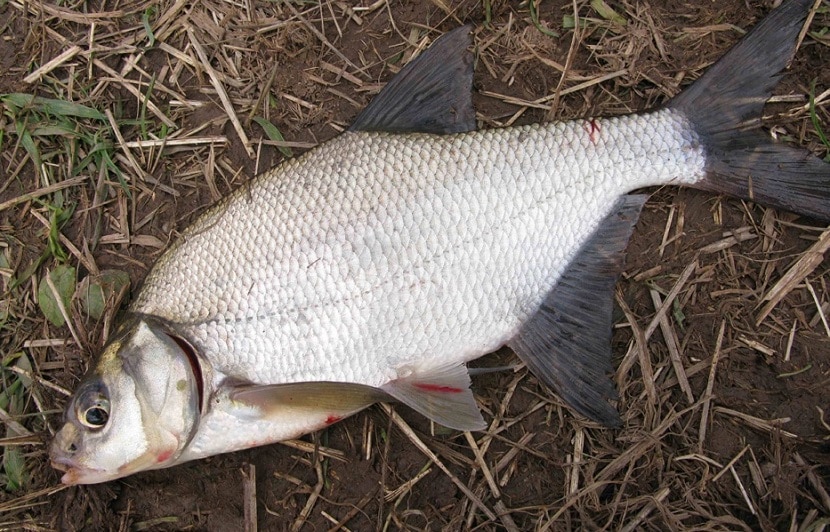
Note! Light feeders are difficult to cast over long distances.
How to equip a feeder rod for carp
Carp is a powerful enough fish, therefore, when starting to complete the tackle, you should think about the fact that a representative of the carp family is able to disable not only the rod, but also the reel, thus cutting off the equipment. The length of the carp feeder should be up to 4 meters. The spool size must be at least 3500-5000 Shimano. You will need a special carp leash with a
diameter of 0.25 mm. Monofilament (0.35-0.4 mm) can be used as the main line.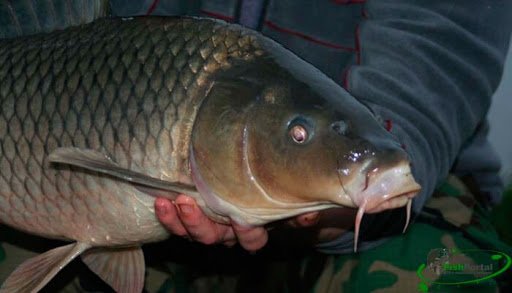
Feeder equipment for catching crucian carp
To catch crucian carp, you do not need particularly strong tackle. The length of the feeder should be up to 3 meters. It is recommended to install a reel with a size equal to 2000. The thickness of the leaders is 0.12 mm, and the diameter of the main line (monofilament) does not exceed 0.2 mm. The size of the hooks should be larger than # 6.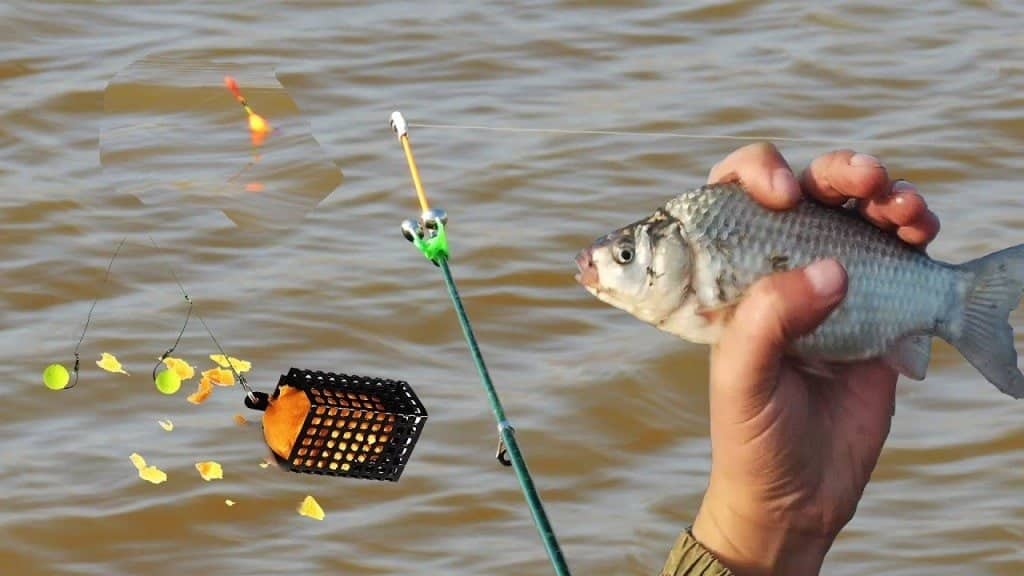
How to assemble a roach feeder
The best option for fishing roach will be a feeder with a dough of 100 grams, the length of which does not exceed 4 meters. The coil size should be up to 2500-3000. Braid is used as the main line (diameter 0.14 mm), so a metal spool should be preferred. When fishing for freshwater fish, all types of mounting can be used. Fishermen choose their rig according to the fishing conditions. Most often used:
- asymmetric loop;
- helicopter;
- inline ;
- paternoster.
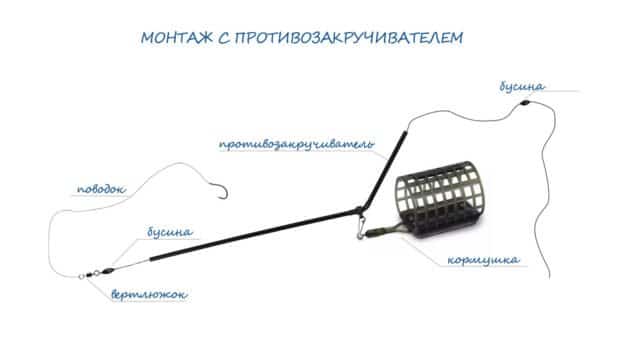
Secrets and Tips
Avid fishermen willingly share secrets and tips regarding the use of feeder tackle.
- When fishing a stagnant body of water, it is worth using inline, looped feeder rigs.
- If there is an increased activity of the fish, you can give preference to the paternoster rig.
- When fishing on rivers with strong currents, it is advisable to use an asymmetric loop or a helicopter.
- To prevent the bait from washing out too quickly, you should use closed feeders.
Going on a fishing trip, using feeder tackle, it is important not only to study the habits of fish living in the river, but also to thoroughly master the tackle, the ability to use a variety of equipment. Thanks to this, the fisherman will be able at any time to mount the most suitable type of equipment for a particular case. A fisherman who is thoroughly prepared for fishing with feeder tackle will never be left without a catch. No tail, no scales!
